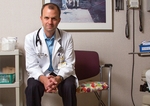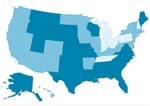Health
Marked increase shown in adult ADHD drug treatment
■ Some view the trend as indicating greater awareness of ADHD in this age group, but others also see the need for more long-term efficacy data.
By Victoria Stagg Elliott — Posted Oct. 10, 2005
- WITH THIS STORY:
- » ADHD grows up
- » External links
- » Related content
Oren Mason, MD, a family physician in Grand Rapids, Mich., had always struggled to focus and to get things done. But it was only when his son was diagnosed five years ago with attention-deficit/hyperactivity disorder that he had an "ah-ha" moment.
"[My son] was hyperactive, and it was rather obvious," he said. "I couldn't remember what the kids needed, and I had a problem with complicated paperwork. My wife said let's get this checked out, and I was diagnosed as having the inattentive form [of ADHD]." As a result, Dr. Mason, whose practice now focuses on care for those with this disorder, is among the growing ranks of adults who are being diagnosed with a condition long associated with children.
Medco Health Solutions Inc., a Franklin Lakes, N.J.-based pharmaceutical benefit manager with 2.4 million members, released in September a detailed analysis of prescriptions for drugs to treat ADHD. Among the report's findings was a significant uptick in those for children. However, this increase was far outpaced by the growth in prescriptions for adults.
"This analysis clearly shows that ADHD is no longer just about children," said Robert Epstein, MD, Medco's chief medical officer.
The data were not published in a scientific journal, and the company did not delve into why these numbers are increasing. Most experts believe, though, that this trend can be accounted for by the Food and Drug Administration's approval of and the resulting direct-to-consumer advertising campaigns for several drugs to treat adult ADHD. These factors in turn translated into a new level of awareness among those older than 18 who may have the condition, which many experts believe has a significant genetic component.
"For 100 years, the focus of ADHD was on children and was more a matter of problems in the classroom," said Lloyd Darlow, MD, a family physician in Ithaca, N.Y., who has a special interest in the disorder. "Over the last few years some of the focus has started to shift. There's much more awareness, and some of the stigma has been removed."
Some of the adult prescriptions may also be accounted for by the reality that as children grow up they continue to need medication. Most experts believe, though, that many adults, like Dr. Mason, may be diagnosed for the first time long after childhood and often in response to their children's experience.
"We work the kid up in the office, and the parent says, 'that sounds like me.' " said Dr. Darlow.
This scenario may be particularly true for adult women who, according to the Medco data, are receiving ADHD drug prescriptions at a faster rate than that for adult men. Experts say this may be because young girls are more likely to have the inattentive form which is less likely to be detected in childhood.
"Girls don't exhibit as much of the same behavior as boys -- such as disrupting the class," said Lon Castle, MD, director of medical policy and programs at Medco. "They may be thought of as just not very bright when they may have an attention deficit."
Whatever the reason, experts in adult ADHD praised the phenomenon because it indicates that more people may be getting help.
"I am encouraged to see the numbers of adults with ADHD taking advantage of available treatments and hope the number continues to increase," said Dr. Mason.
But some experts expressed concern that the numbers were still not high enough. The Medco data indicate that about 1% of adults are being treated for ADHD, although many suspect the prevalence to be more than 4%.
"It's not surprising that prescriptions for adults have increased," said Lenard Adler, MD, director the Adult ADHD program at New York University School of Medicine.
"But there's still much more undertreatment than overtreatment, and the consequences are significant. [These patients] are more likely to be divorced or unemployed and to abuse substances. It's a real public health issue," Dr. Adler said.
Drug efficacy and abuse concerns
The number of prescriptions for both children and adults, though, is also drawing some red flags.
Last month, the Drug Effectiveness Review Project at the Oregon Evidence-based Practice Center in Portland released its report on ADHD medications finding that data comparing the efficacy of one drug to another were lacking as was evidence demonstrating that these drugs improved quality of life.
"We're not disputing that the drugs work and should be used, but it's surprising to see how little evidence there is that helps physicians determine if there are any differences between these drugs," said John Santa, MD, MPH, the project's medical director. "We need better research."
In addition, critics urged caution because of fears that these patients or those around them could have addiction or abuse issues.
"It may represent an individual good, but in the end the societal costs may be too high," said Lawrence H. Diller, MD, author of Running on Ritalin and a behavioral and developmental pediatrician in Walnut Creek, Calif., who has treated both adults and children with these drugs. "Tolerance is a real phenomenon in the teenage years and adults. A great deal is being diverted."












